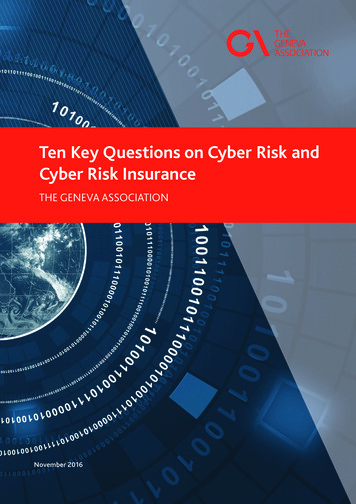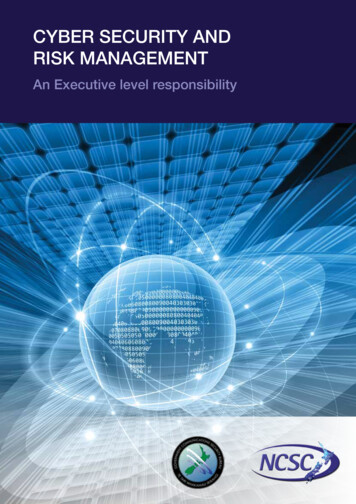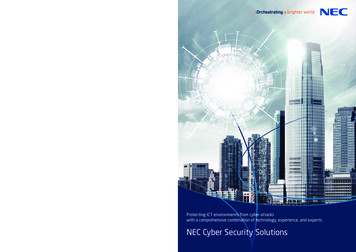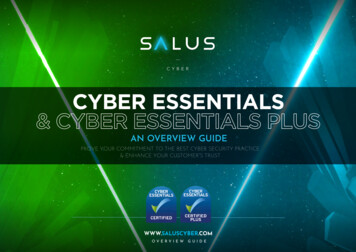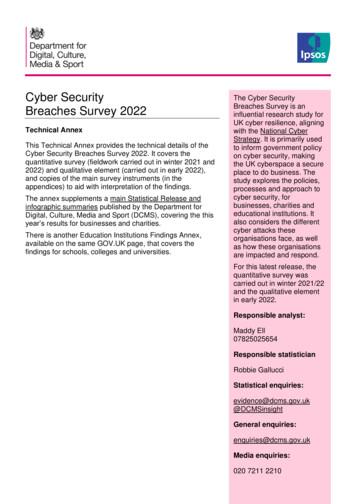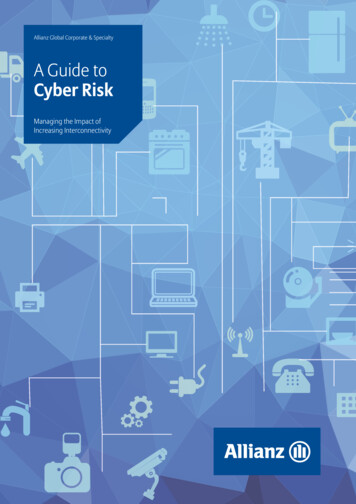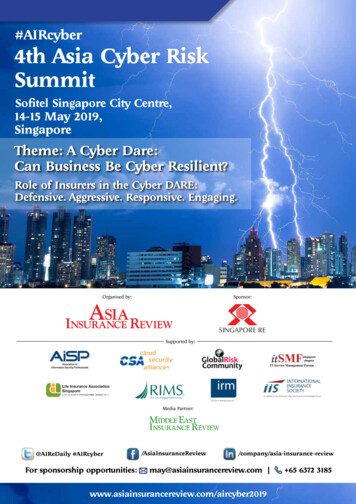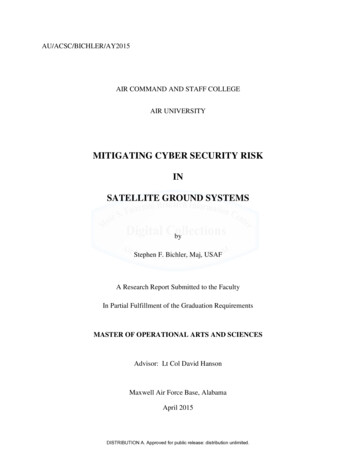
Transcription
AU/ACSC/BICHLER/AY2015AIR COMMAND AND STAFF COLLEGEAIR UNIVERSITYMITIGATING CYBER SECURITY RISKINSATELLITE GROUND SYSTEMSbyStephen F. Bichler, Maj, USAFA Research Report Submitted to the FacultyIn Partial Fulfillment of the Graduation RequirementsMASTER OF OPERATIONAL ARTS AND SCIENCESAdvisor: Lt Col David HansonMaxwell Air Force Base, AlabamaApril 2015DISTRIBUTION A. Approved for public release: distribution unlimited.
1
DisclaimerThe views expressed in this academic research paper are those of the author and do not reflect the official policy or position of the US government or the Department of Defense. In accordance with Air Force Instruction 51-303, it is not copyrighted, but is the property of the United States government.2
TABLE OF CONTENTSABSTRACT .4INTRODUCTION.5BACKGROUND .7Space Ground System Overview .7Cyberspace Components of Satellite Ground Systems .9CYBER THREATS TO SATELLITE GROUND SYSTEMS .10Cyber Espionage .10Cyber Exploitation and Access Operations .12Cyber Attacks on Ground Systems.14CURRENT CYBERSECURITY RISK MITIGATION FOR GROUND SYSTEMS .18Cybersecurity Compliance .18Cybersecurity in Acquisition .20Cybersecurity in Operations .21NON-DOD RISK-BASED EVALUATION FOR SPACE SYSTEMS .23SANS Top 20 Security Controls .24The Quantitative Model: Time-Based Security .27Preventative Security.29ANALYSIS AND RECOMMENDATIONS .30CONCLUSION .333
ABSTRACTSatellite ground systems represent an often neglected aspect of cyber security when discussing Air Force and Department of Defense cyber vulnerabilities. An increasing amount ofcyber security research and attacks focus on space ground systems in the form of satellite control, satellite communications terminal hacking, and GPS spoofing. Public evidence existsdemonstrating nation-state adversary willingness and intent for attacking these systems. Groundsystems find themselves in a gray area of compliance between the two cyber security risk management regulations DoDI 8510 and Committee on National Security Systems Instruction 1253.Both require compliance to security controls, but neither build in the evaluation or mandatorycontrols necessary for the mitigation of risk. A further examination of private industry standardsand theory shows better methods of mitigating cyber security risk via simplifying the securitycontrols necessary, using time-based methods for analyzing controls, and conducting preventative cyber security engineering on new systems for the provision of information assurance.4
INTRODUCTIONFor decades space systems provided the United States an unparalleled political andmilitary asymmetric advantage over other near peer states. Similarly the growth of cybertechnologies in the United States from the birth of the Internet to today provided an unparalleledinformation advantage. Coupled together space and cyber technologies emboldened the rapidmilitary successes of the 1990s as space technologies such as satellite communications, GlobalPositioning System (GPS), space-based intelligence surveillance and reconnaissance, andweather data fused with global data networks and databases allowing the near instantaneoussharing of data. The network-centric warfare models of the late 1990s and early 2000s created asecondary effect as space and cyber technologies coupled together for an unprecedented speedand information processing advantage. The acquisition and operations communities regardedthe security of the data, the links, and ultimately the space systems themselves as secondary.Many of these technologies remain in the United States’ inventory today, built using thesame insecure cybersecurity model. The ground system and user terminals represents the mostvulnerable portion of a space system to cyber security threats. A ground system consists of thenetwork of computers, antennas, and functions commanding and controlling the on-orbitsatellite. An example of a ground system is the Air Force Satellite Control Network (AFSCN).A user terminal consists of the devices provided to warfighters for receiving satellite signals.Common user terminals are radios, GPS receivers, satellite phones, satellite communication(SATCOM) terminals. The chokepoint for both cyber and space technologies rests with theground systems where the transfer and translation of data occurs. Although updated regularly,per Department of Defense (DoD) and Committee on National Security Systems (CNSS)regulations, these ground systems remain vulnerable to cyber-attack. Often times, these systems5
receive waivers from security updates due to perceived “performance” issues with the satellite,or operate on slower update schedule due to contracts or operational constraints. All systemstechnically meet the compulsory guidance for information assurance risk management (DoD8510.1 and CNSSI 1253) and any risks were accepted by the representative Chief InformationOfficers within DoD who manage the systems.1 However, compliance doesn’t mean security.There have been several breaches of space ground systems over the last decade and aconcentrated effort by adversaries to gain access to American space technology throughcyberspace operations. Better methods for identifying and mitigating risk in satellite groundsystems will continue as essential tasks in keeping the United States’ significant space advantage.The current guidance does not go far enough to mitigate these threats, because adversaries willcontinue to attack cyber systems and satellite links as these are easier and cheaper to access thanthe satellites on-orbit.Although space ground and control systems meet Department of Defense (DoD)compliance policies for cybersecurity, these systems lack an iterative continuing cyber securityassessment process for discovery, risk analysis, mitigation and remediation of advancedcyberspace threats throughout the space systems’ lifecycle. Space ground and control systemsrequire new methods of risk-based compliance, and frequent evaluation of cybersecurity risk tospace operations and a renewed focus on engineering away the weaknesses of systems at theirinception; only then will US cyber systems supporting space operations be considered secure andavailable in conflict.6
BACKGROUNDSpace Ground and Control Systems OverviewA vast array of components make up satellite ground systems and receivers, as defined inthis paper. These include the earth terminals and user receivers, which translate the satellitesignal to usable data to the user receiver devices which make up the largest segment of theground components of satellite. They also include the command and control network the AirForce uses for keeping the satellites operational.The user terminals and devices represent the most ubiquitous element of a satellitesystems. Examples of these devices include major satellite earth terminals which power largemilitary bases or even metropolitan areas with SATCOM signals; the SATCOM tactical radiosused in countless military and commercial vehicles, vessels and aircraft; and the wide variety ofGPS receiver devices. All of these devices possess some processing and computing power usingcyberspace technologies.Just as important as the technical components of the systems, the command and control(C2) structure for space ground systems aids in their survivability to most attacks as proceduralredundancies aid system operations. The preponderance of military space assets receive theirC2 from the Joint Space Operations Center (JSpOC) at Vandenberg Air Force Base, whiletactical and administrative control falls to the 50th Network Operations Group of the 50th SpaceWing at Peterson AFB, Colorado.2 For NASA space assets, Johnson Space Center and GoddardSpace Center possess the ground systems for control of space assets.Within the 50th Network Operations Group, the Air Force Satellite Control Network(AFSCN) is the ground system responsible for C2 of a large preponderance of DoD satellites.This network consists of a massive, globally connected grid of manned and unmanned sites7
which maintain control of satellite actions from earth. Management of AFSCN operations occursat Schriever AFB in Colorado where AFSCN receives its tasks for satellite operations from theJoint Space Operations Center. The backup communications node is at Vandenberg AFB. Thereare seven additional tracking sites throughout the world providing control information tosatellites when they are overhead. Enabling global operations requires the placement of thesesites globally in the Pacific, Greenland, the United Kingdom, and the east and west coasts of theUnited States. Additionally, AFSCN maintains a number of transportable units in theeventuality that a site goes down or C2 need reestablishment due to a catastrophic event whichmay occur at both Vandenberg and Schriever AFBs. The AFSCN computer systems vary intheir connectivity to the outside world affecting their vulnerability to cyber-attacks at thedifferent sites. Office automation systems connect to the Air Force network for unclassified andclassified communications. The Air Force network connects via commercial circuits to theInternet for unclassified communications. The satellite control network operates in conjunctionwith the other sites and the JSPOC, but does not connect to any open Internet connections; bydesign it is a closed network. Again the degree of isolation varies by site due to the dependenceon commercial circuits within the DoD. Finally, communications with the satellites themselvesare isolated communications between the ground station terminal and the satellite receiving thecommands; this also represents a closed network. On its face, this seems like a fairly securedesign. However, opportunities and precedent have shown cyber penetrations into these closednetworks.3The 2nd Space Operations Squadron uses a similar system for the management andmonitoring of the GPS constellation. A main control ground station exists at Schriever AirForce Base with a secondary site at Vandenberg AFB and monitoring sites around the world8
which are both manned and unmanned. The satellites orbit in the Geosynchronous belt meaningthe signal is very low powered requiring many stations throughout the world for monitoring andmanagement. Currently, five manned monitoring sites exist for GPS. GPS sites often co-locatewith AFSCN sites and other United States Air Force satellite management and space surveillanceground stations. However, their operations remain separate. 4This consolidation effort will likely continue as Air Force budgets constrain further in thecoming years. The increased reliance on information systems and automation may power thisconsolidation meaning a greater reliance on the cyber components of ground stations. The AirForce’s Consolidated AFSCN Modernization, Maintenance and Operations or CAMMO contractwas recently won by a team including Lockheed-Martin. The number one requirement accordingto Lockheed’s press release and web site was cyber security for the AFSCN during themodernization and consolidation. This acknowledgement by both the Air Force and its largestcontractor on the project points to the importance of cyber security at the ground stations.5Cyberspace Components of Satellite Ground SystemLike most of the digital world, space systems depend on cyberspace systems.Strategically, the Joint Space Operations Center and the NASA Operations Center usecyberspace technology for space surveillance and monitoring of space objects.Bothorganizations use cyber technologies in the operation of their satellite systems via largeintegrated computer networks. The congestion of space requires a robust surveillanceinformation system cataloging thousands of objects. The record-keeping of these objects doesnot fall in a standalone specialized information system, but in an off-the-shelf data warehousesolution. Space system data represents a gold-mine for potential nation-state adversaries.Whether a government system or a contractor system, space data remains in high-demand among9
nations developing space programs, and non-state actors interested in the information on thesesatellites. There were 15 publicized cyber intrusions into government space systems from 20052013, all coming from NASA.6Operationally, satellite ground systems rely on cyberspace technology at every turn. Thespace operators work off console systems, utilizing computer systems and digital data for themaneuver, control and manipulation of satellites. The AFSCN and GPS control networkintegrate their respective global communications networks of satellite ground stations,monitoring stations, and satellite links melded together through cyberspace for the overallcontrol of Air Force satellites across the global monitoring of space.7, 8At the tactical level satellite communications, ground terminals exist linking the satellitefeed into the communications network of customers. For the military, this includes tacticalunclassified and classified networks directly interfaced to satellite terminals for data access.These satellite ground terminals represent a particularly vulnerable point for a satellite system. Itis the place where cyber technology and space technology converge at a chokepoint and mustspeak the satellite's unclassified language for the uplink and downlink of data. This is often anopen telecommunications protocol such as Transaction Language 1 (TL1), a common satellitecommunications protocol used in military SATCOM.9 Navigation systems also rely oncyberspace technologies for map overlays and integration of position and timing data into usableinformation. Communications, positioning and timing exist as vital assets to tactical users.CYBER THREATS TO SATELLITE GROUND SYSTEMSCyber-Based EspionageThe United States' unparalleled advantage in space, particularly in satellite operations, is10
due in large part to the massive amounts of research, development, and intellectual propertyaccumulated over the last sixty years of the United States' efforts in space. Unlike in the 1960s,when much of this intellectual property remained locked behind classified fences at governmentfacilities, the distribution of intellectual property through the government, universities and largecontractors are much more accessible in digital form.Nation-states seek this trove of information either for the building of their own spacecapabilities or the effective countering of US capabilities. From 1997-2013 in open source, therewere 12 instances of cyber espionage attacks against NASA networks. These culminated withthe arrest of Chinese national and NASA contractor Bo Jiang attempting to flee the United stateswith “a large amount of information technology he may not have been entitled to possess” in2013. The Jiang incidente incited the expulsion of 118 Chinese nationals from NASA contractwork because of the fear these individuals were acquiring schematics, engineering diagrams,signal schemes and research data for various US space platforms. Additionally, from 20032006 a massive Chinese network infiltration campaign dubbed “TITAN RAIN” by lawenforcement and intelligence officials targeted DoD, NASA, aerospace contractors and researchinstitutes searching for information on space propulsion systems, solar paneling and fuelsystems, as well as other Department of defense acquisition targets.10 More recently the muchpublicized Mandiant Technology report exposing “Advanced Persistent Threat (APT) One” on aChinese People’s Liberation Army (PLA) cyber unit showed the aerospace and satelliteindustries as the second and fourth most targeted industries of just this one particular PLA cyberespionage unit.11China grabs the most headlines with cyber espionage, but they are definitely not alone.Numerous unattributed infiltrations occur at many top space and aerospace firms over the last11
several years. A group of Romanian hackers stole sensitive data from both NASA and theEuropean Space Agency in an effort to sell the data on the black market. Eventually, not findinga buyer, they released a majority of the stolen information on the open internet. The Romanianincident shows espionage is not simply a “China” problem.12These incidents of espionage represent the publicized incidents which occurred, becausecyber security in government remains shrouded in secrecy. However, using the DefenseOperational Test and Evaluation Office’s (DOT&E) FY14 report on cybersecurity one grasps theseriousness of the problem. DOT&E reported only 85% of networks in DoD were compliantwith the cyber security regulations discussed later in this paper. Not until compliance is near100% could DOT&E conceive with confidence that DoD networks were safe from adversaryintrusion and data exfiltration. One of the key findings of the FY14 DOT&E report dealt withshipboard SATCOM datalink vulnerabilities, indicating again the targeting of space systems.13Cyber Exploitation & Access OperationsIn the discussion of cyber espionage the question “how does this happen” should resonatein the reader’s mind. Cyber exploitation is the how. Cyber exploitation is the means of gainingand maintain access in a computer network and pre-positioning oneself in the parts of thisnetwork which provider the intruder with access to the information they seek. In the UnitedStates, cyber exploitation usually coincides with intelligence and espionage missions, but theexploitation of systems is necessary whether the mission of the intruder is theft, interruption,damage or destruction from cyberspace. Access is the key in any cyberspace operation andexploitation represents the means to access.14The most common scenario for a network’s exploitation are web page attacks which breakup in three categories known as cross-site scripting, cross-site request forgery, and “drive-by”12
hacking. These attacks make up three of the Top 10 vulnerabilities according to the Open WebApplication Security Project, an independent group studying internet security. In a web pageattack, the hacker finds vulnerabilities in a website used by the people they are targeting. Thesevulnerabilities allow the attacker to redirect the target to another website which downloads aprogram to the target, commonly known as a trojan horse. Often this secondary website remainsinvisible to the target, made so by manipulating the user’s screen and hiding the nefarious pagein one pixels unnoticeable by the human eye. The trojan horse allows the intruder initial accessin a network, from there the intruder will move throughout the network attempting to gain thecredentials needed to gain further access into the system.15The other common method for network exploitation are phishing attacks. Phishingattacks receive much publicity as they have proven responsible as the initial exploitation in mostmajor commercial and government cyber-attacks of the last decade. In a phishing attack, a targetreceives an email with a nefarious link to a webpage, often believed a legitimate webpage. Thisweb page downloads the Trojan to the target. Then just like a web page attack the attackermoves on to other portions of the network looking for the information or setting themselves up topersistent on the network if their intent is triggering an attack. 16 According to the DOT&Ephishing and web exploitation make up the vast majority of intrusions executed by DoD cybersecurity evaluation teams and known adversaries. These attack vectors represent the most likelyaccess operations.17The most dangerous method for a space system’s exploitation comes through the use of an“air gap” tool, bridging the separation between a space ground system network and the officeautomation systems and networks. The AFSCN and GPS control networks are missionnetworks controlling sensitive assets, but they are not classified. Therefore, some of the controls13
placed on classified networks do not apply. Therefore, the attachment of an infected storagedevice (USB thumb drive, external hard drive, infected CD-DVD, or smartphone) couldinadvertently allow an adversary access to a space control network. This would be uncontrolledaccess because the adversary could not access their software once deployed. The precedent forthis type of exploitation already exists in the forms of the STUXNET virus in Iran and theagent.btz infection of USCENTCOM networks. In both the incidents the attackers deployed themalicious software to air gapped networks. That software ran its malicious payload. In the caseof STUXNET, a destructive payload caused damage to Iran’s nuclear reactor.18 In the case ofagent.btz, the results are not widely publicized, but it proved adversary ability to infect classifiednetworks.19 An air-gapped infection vector against AFSCN or GPS could cripple the Air Force’sability to control its on-orbit satellite resources. Particularly, if the attack occurred at the primaryand secondary sites with the malicious software only activating if it recognizes itself being on asatellite control network, similar to how STUXNET worked. 20How would an adversary persist and maintain access on space systems? A multitude ofweaknesses inherently built into satellite receivers, ground systems, and network componentsmake persistence for a cyber-adversary not only possible but probable. These are not “hacks”,but methods built-in by manufacturers and contractors overlooked during the initial build ofsystems. For example, the Mandiant report discusses in multiple areas how APT1 used built inWindows administrator commands to fortify and expand access in targeted computer networks.21Cyber Attacks on Ground SystemsThe targeting of space ground systems increased over the last decade with some extremelysophisticated attacks occurring over the last two years. The following examples chronicle veryhigh-profile cyber vulnerabilities and breaches illustrating the importance of developing adaptive14
methods for the security of these ground systems.NASA, by far, represents the most transparent organization in terms of cyber securitybreaches, with both of the following breaches originated from China. Besides the cyberespionage indicated earlier, NASA also experienced several exploitations and attacks which areconcerning for space professionals. In 2007, Goddard Space Flight Center experienced anetwork penetration leading to data theft regarding earth observation systems. Later that yearand in 2008, the earth observation satellite Landsat-7 experienced multiple incidents ofinterference caused by cyber-attack. In October of 2008, cyber intruders hijacked another earthobservation satellite, Terra-EOS AM-1, who not only caused interference, but also achieved allsteps necessary for control of the orbiting satellite. The only thing stopping these attackers fromcommanding the satellite was an understanding of the actual commands for satellite maneuver.22Additionally in 2008, hackers infiltrated the Johnson Space Center’s mission controlcomputer network and were able to have the mission control network upload a malicious Trojanhorse access program onto computers on the International Space Station disrupting on-boardcommunications, but not endangering the crew or space flight itself. This attack occurredbecause the ISS computers were not receiving vital software updates to their operating system.23In October 2012, security researchers at Carnegie-Mellon University found several severevulnerabilities in major government and commercial grade GPS receivers’ software whichrendered GPS’s precision timing invalid. Instead of spoofing or jamming the GPS signal asmany other attackers previously conducted, these researchers attacked the inherent weaknessesof GPS’s design to disrupt the timing. The attackers falsely set the GPS receiver’s location inthe software to the center of the earth (i.e. the earth’s core), because GPS orients itself off theposition of the receiver on the earth’s surface in conjunction with the location of the receiver on15
the earth’s surface. Based on the faulty position, the receivers would either reboot or reject the“middle-of-the-earth” attack data, but this caused permanent corruption of the timing data on thereceiver as a secondary effect. Next, the attackers used weaknesses in the operating systemsoftware of the receivers to set the date/time of the operating system outside the bounds of theGPS’s epheremis timing by 20 years. In so doing, allowed the attackers to reset the timing ofGPS at a rate of 40 years per minute, invariably causing the GPS receiver to rollover to a newtiming epoch in about 2 days. This desynchronization of timing then flows to the othernetworked systems and breaks the timing throughout a network using GPS timing. 24 This type ofcyber-attack on GPS shows the vulnerability and dependency DoD and other computernetworked systems have for precision timing. A most concerning scenario, would be if the GPScontrol network itself were attacked and this data used to desynchronize timing throughout thesatellite system. Although unlikely, it is concerning these issues were found in GPS receivers. Itbegs the question of whether these issues remain at the satellite control level as well.At the 2014 major hacker convention DEFCON, security researcher Ruben Santamarta,released a report showing the attack and control by cyber attackers of ten of the top military andcommercial SATCOM terminals on the market.Santamarta’s research included some technicalreverse engineering of SATCOM terminal software, but nearly all of the vulnerabilities foundresulted from open-source research in the manuals and documentation of these systems. Hediscovered weak default passwords, normally left in place by default. Additionally, programmerbackdoors from data units which control user communications and control units which controlaccess to the satellite were easily discoverable and left in default modes. Finally, protocols forcommunications between the satellite control units and the user interface had weakauthentication mechanisms, easily guessed or captured by Santamarta’s team. Concerning for16
the DoD is Santamarta’s research included the Harris PRC-119 radio used in most tacticalvehicles, the Thuraya IP SATCOM terminal which was used in morale and welfare networks inAfghanistan, and the Cobham Aviator SATCOM terminal used in the C-130J. All werevulnerable to attacks requiring little technical knowledge, but only a good deal of curiosity andaccess to the network itself. Figure 1 represents the list of vulnerabilities discovered on eachtype of terminal.25Fig 1 – SATCOM Vulnerabilities from IOActive Whitepaper2617
In August 2014, the Department of Commerce Inspector General released a scathingreport on unpatched security vulnerabilities throughout the ground systems of the Joint PolarSatellite System (JPSS). JPSS is the follow-on weather observation satellite system for both theNational Oceanic and Atmospheric Administration (NOAA) and the DoD. The ground systemreceived failing marks in its 2012 cybersecurity audit, but provided several solutions to “getwell” before its next evaluation. When the follow-on evaluation finally came two years later notonly were the 2012 vulnerabilities not fixed, but several thousand other vulnerabilities werediscovered. The findings were so severe a fear existed the entire program could be cancelled.However, NOAA and DoD deemed JPSS too important due to satellites already being on-orbit.The vulnerabilities found in 2012 numbered over 14,000 and numbered over 23,000 after theJuly 2014 evaluation. The cause determined by the inspectors coupled a complacency incompliance by internal auditors at NOAA with an unwillingness to deviate from scheduledupdates by the JPSS contractors. This issue of deviation matches issues DoD space programsexperience when trying to address time-sensitive cyber vulnerabilities against an acquisitionschedule of a mission-based system.27 Two months later in November of 2014, NOAA revealeda satellite system breach by nation-state attackers believed to be from China. NOAAdiscontinued the release of public satellite imagery from its website for over a week due to theattack. 28 An unnamed NOAA source stated “the Chinese are robbing us blind” of satellitetechnology.29 This example shows a direct correlation bet
Satellite ground systems represent an often neglected aspect of cyber security when dis-cussing Air Force and Department of Defense cyber vulnerabilities. An increasing amount of cyber security research and attacks focus on space ground systems in the form of satellite con-trol, satellite communications terminal hacking, and GPS spoofing.


